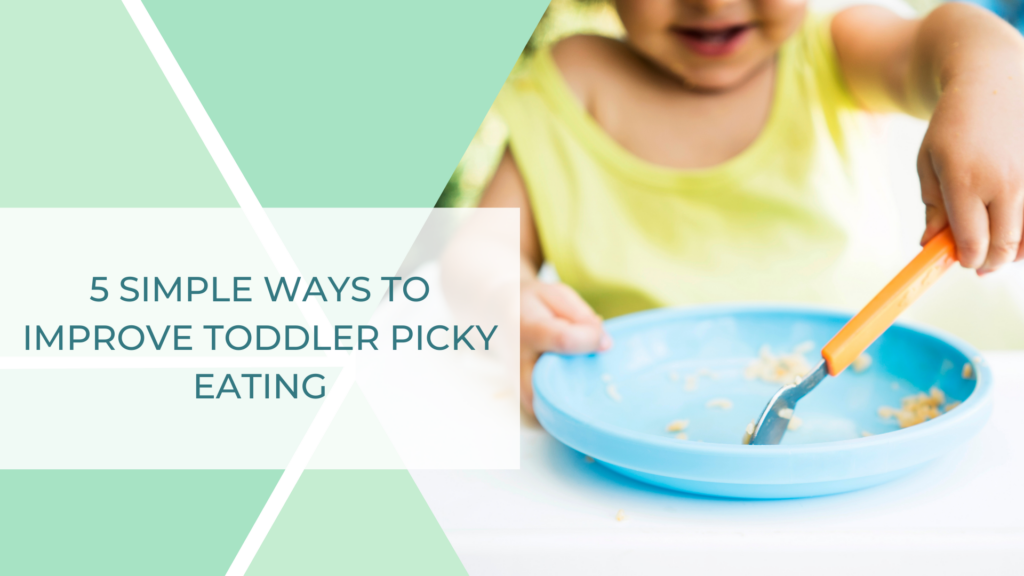This article answers all your questions about toddler picky eating and shares tips on how you can improve your toddler’s eating today.
You’ll learn:
- Why toddlers are picky eaters
- What toddler picky eating looks like
- 5 simple things you can do to improve toddler picky eating
- What you can do to improve toddler picky eating

Your baby grew up devouring kale and roasted salmon…and all of the sudden when they turned two, they turned into a discerning toddler who prefers french fries and applesauce to anything with a more vibrant flavor or appearance.
Anywhere from six to 50 percent of children display selective eating behavior at some point and most parents report one or more problems with their child’s eating from the ages of two to six. Which is all to say, toddler picky eating is extremely normal.
Which might be reassuring but doesn’t make it any less frustrating.
So what is happening? Why is this such a common age to see a dramatic change in eating habits? And how can you get back that baby who used to eat peas and avocado by the handful, but now hasn’t touched a vegetable in a week!
What’s Happening With Your Toddler’s Eating (hint, you’re not doing anything wrong)
According to the research, picky eating behaviors most often start right around the two-year mark. But don’t be worried if you notice your child limiting the variety and quantity of foods they eat earlier; many parents see a change in eating habits around 18 months.
So what’s going on with kids at this time?
A lot of different things all at once:
- Decreased nutritional needs
- Slowed growth
- Increased desire for autonomy (aka your toddler realizing they can say no)
- Preference for self-feeding
- Desire to participate in food selection
- Heightened taste buds (particularly to bitter flavors….vegetables!)
- Distrust of new things (along with the change in taste buds this could be an evolutionary vestige meant to protect increasingly independent children from eating poisonous foods)
- Normal toddler things like big feelings, strong preferences, and general unpredictability
What Does Toddler Picky Eating Look Like?
Every child’s eating habits are unique, but these are some of the classic signs of picky eating in toddlers
- Rejection of preferred foods
- Refusal to try new foods
- Strong and constantly evolving preferences
- Variable appetite
- Preference for bland foods
- Hyper-attention to detail (noticing every speck of black pepper and stray piece of parsley)
- Increased desire for autonomy
What You Can Expect From Toddler Picky Eating
Here’s the great news: Many kids do naturally outgrow their particular preferences and resistance to trying new foods by the age of six.
And here’s some less great news: Four years is a long time to stress, worry and dread mealtimes
Finally, the hard news: There are some estimates that over 50% of children continue to struggle with their eating until grade school and beyond.
How to Know If Your Toddler’s Picky Eating is Normal
It’s normal to worry about your toddler’s eating and wonder if what you’re seeing is normal or something that might need more attention.
Here are signs of typical picky eating:
- Preferring plain foods
- Eating less than they used to or having variable intake
- Resists try new foods
- Rejecting vegetables
- Disliking mixed dishes and sauces
Here are some signs of eating challenges that aren’t as typical:
- Hasn’t tried a new food in a long time
- Doesn’t eat entire food groups (ie no meat, no vegetables)
- List of preferred foods is shrinking
- Gags when tasting or looking at a new food
- Anxiety at mealtimes
The First Things To Do When Toddler Picky Eating Starts
Continue to serve foods they used to eat: You can serve these in small portions the same way they were used to eating them or change up the presentation a little.
Offer new foods: Your child can’t ever eat a new food if they’re not meeting new foods. Beyond needing the opportunity, exposure is a crucial part of the learning process.
Do hands-on food activities: Kids learn by touching, seeing, smelling, and interacting with new foods. The more a child explores a food, the more likely they are to taste it. I love gardening, grocery shopping, cooking, playing, and exploring.
Here’s how you can learn more and get ideas to do hands-on activities at home:
- Why Gardening With Your Picky Eater Is a MUST
- 5 Ways to Play with Food This Summer
- Why You Should Let Kids Play With Their Food
- How to Get Your Picky Eater Excited About Cooking
Look at a week of eating: It’s normal for the appetite to change day-to-day. So, don’t look at what they eat over a day, look over a week. One day is just one day (out of 365 in a year!). One meal is just one meal out of too many meals to count. Focus on the big picture.
Adjust your expectations: The more it seems like you want your child to eat, the less they will want to. The decision to eat needs to come from your child. Be okay if your child doesn’t taste the first time you offer a new food or try a new strategy.
What Should You Do If Your Toddler Is A Picky Eater
Your child will go through (and probably has already been through) many challenging yet normal ages and stages (sleep regressions, terrible twos, potty problems, tantrums, etc.). You’ve made it through every challenging moment and you will make it through more.
Picky eating is one of those parent challenges that might be “normal” and still feels really hard.
You will definitely make it through. How you feel in the process and when that time comes – that’s something you have control over.
I am a big believer that if you are feeling stressed and worried, especially if you feel like something “more” is going on, then it’s important to listen to that instinct.
Can picky eating struggles in toddlers be normal and totally age appropriate? ABSOLUTELY! Is it always? No. Will they grow out of it? Likely YES at some point.
But are mealtimes the worst part of your day? Do you feel like you’re doing everything wrong? Are you so worried your child isn’t getting the nutrition they need to thrive?
Just because something is “normal” doesn’t mean you don’t deserve support.
The toddler years – when picky eating behaviors are still in their infancy– is the ideal time to help your child feel more comfortable and open with new foods. With support you can get there faster, more directly and easier than doing it all on your own, either waiting it out or trying to piecemeal tips together.
If you’re ready for support, you can book a call with me.




0 Comments